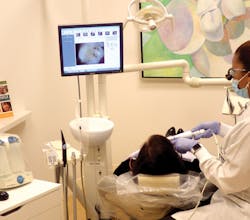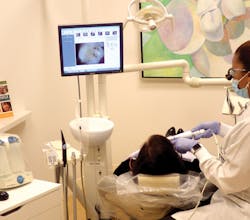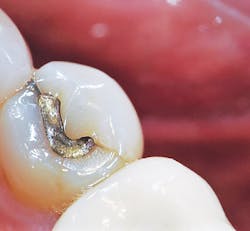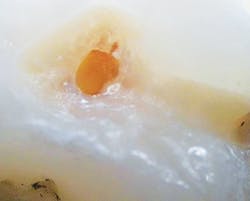Synergy and the patient provider relationship, part 2: is restorative treatment being diagnosed in hygiene?
The dental hygienist sets the stage for a discussion about restorative dentistry
By Ronald E. Goldstein, DDS, and Yemia White, RDH, BSDH
Figure 1: One of the most important parts of the hygiene appointment is when the hygienist takes intraoral photos of questionable areas for the dentist to review.
In a recent staff meeting about new technology being implemented into the practice, one of our fellow colleagues, a dental hygienist, made a comment that really resonated with us. She said, “When it comes to the doctors’ side of things, sometimes it feels like the hygiene team gets left out, like we are in own world.”
She had a valid point and we could see how that could easily happen. An experienced dental hygienist may have heard this sentiment before. However, we hope that for both seasoned hygienists and new graduates, this article will provide knowledge to help improve the outcome of treatment diagnosed during recare appointments.
Technology, including the digital revolution now taking place, dental products, materials, and techniques, change so fast that it has become a real problem keeping up. “The fact that your hygienist should have excellent clinical skills is a given; the fact that she (or he) should be equally skilled in diagnostic principles is not as widely recognized.”1 Generally speaking, the hygienist focuses on educational and preventive treatment and the dentist/assistant focuses on restorative treatment. According to the ADHA, “The distinct roles of the dental hygienist and dentist complement and augment the effectiveness of each professional and contribute to a collaborative environment., 2 thereby making the importance of the interconnectedness between the hygiene and dental team essential for the practice’s success.
Figure 2: An essential finding with the intraoral camera was this seemingly simple occlusal amalgam, but note the macro- and microcracks emanating from the restoration that could cause a major fracture or even a split tooth if the patient bit into a seed or any sharp crust of bread.
During a periodic or comprehensive examination, both the dentist’s and the hygienist’s collective findings and co-diagnosis can solidify the patients’ trust in the office team. Conversely, it may create mistrust and confusion if they hear conflicting information. According to the ADHA, “The dental hygiene diagnosis and care plans are incorporated into the comprehensive plan that includes restorative, cosmetic, and oral health needs that the patient values.” 2 Therefore, when collecting information to assess the patient’s restorative needs, it is important to know what to look for and how to anticipate the doctor’s diagnosis. Also, knowing what the practice philosophy is and being aligned with that philosophy will ensure the dental team has a common goal.
Collecting Data
First, knowing what to look for requires being interested in learning from the doctor and dental assistants about procedures that may be unfamiliar. If downtime permits, observe dental procedures. Reading information about treatment can be further enhanced through visualization. Being knowledgeable about dental procedures enables better patient education. After all, patients expect their hygienists to be knowledgeable about virtually all phases of dentistry.
One good way to learn about indications and contraindications of each esthetic treatment is by reading Change Your Smile (Amazon.com). There are before-and-after photos of most every treatment with essential information to help you as well as your patients better understand which treatment options might be most suitable for them. The best part is that patients will be able to understand and know which questions to ask.3
Chart Review
Second, complete a chart review prior to patients’ arrival. According to Christensen, recommended treatment can be divided into two categories, elective and mandatory. “Obviously, the mandatory treatments are the ones that are causing pain (caries), or objectionable disfigurement, while the elective ones are those that could be postponed.”4 Make notes to re-evaluate previously diagnosed elective treatment or any areas that are being “watched,” so you will later be able to let your dentist know what to look for. Read the last hygiene chart notations and any additional notes after his or her last hygiene appointment, to stay informed about the patient’s progress in dental treatment.
By doing so, outstanding treatment can be reviewed with your patient, and he or she can be scheduled for the next phase of treatment upon check out. Review bitewing x-rays for interproximal decay, subgingival calculus or cement, bone loss, open contacts, open crown margins, and overhangs. Specific concerns or outstanding treatment needs can be discussed in the morning or afternoon huddles.
When the patient arrives, in addition to reviewing medical history and checking blood pressure, it’s a good idea, if necessary to update x-rays and intraoral photos before the start of treatment. By doing so, patients can see how their mouth looks prior to hygiene treatment and the images will be readily available for the doctor examination.
If time permits, complete a tour of the mouth with the intraoral camera. Understandably, without assistance, this may be challenging for the hygienist who sees patients in 45-minute intervals. If time won’t allow, take a few photos of mandatory concerns, and make a note to take more photos of elective concerns at the next hygiene appointment when you might have more scheduled time.
An intraoral photo taken from different angles can capture areas of gingival inflammation, plaque and calculus formation, gingival recession, oral lesions, wear patterns, failing restorations, and tooth decay.5 Research indicates, “As a result of a comparison between the unaided visual examination and operating microscope, the use of an intraoral camera improved the restorative treatment decisions of the occlusal surfaces on posterior teeth”6 (see Figure 1).
Although dentists do check the entire oral cavity, having the essential photos, which enlarge possible carious sections of the tooth up to 20 times, is extremely helpful. Most busy practices just do not allow the dentist to spend adequate time away from his or her appointed patients to do a thorough clinical exam unless there is help from the hygienist.
Figure 3a: Although this stain in a maxillary molar seems innocuous, the intraoral camera shows that a previous sealant had partially come out. Using the DIAGNOdent, the stain measured 21, showing it needed to be addressed.
Figure 3b: When the author/dentist later opened the area with air abrasion, he discovered caries was spreading below the remaining sealant.
Figure 3c: The final photo shows the extent of the restorative procedure using a hybrid composite resin.
Patient Education
When assessing restorative needs, utilize the intraoral camera to observe margins of crowns, sealants, composites, and amalgam restorations. Careful attention should be given to micro-cracks extending from restorations. Studies show that in addition to secondary caries, the second most common reason for amalgam restoration failure is fracture which includes marginal ridge fracture, bulk/isthmus fracture and tooth fracture”7 (see Figure 2).
The authors have also documented numerous defective older sealants using the intra-oral camera but not seen in the clinical exam (see Figure 3 a-c).
Most of all, engage the patients. Show them photos of their teeth and discuss areas of concern. Allow them to ask questions and ask them if they see anything that looks concerning to them. Avoid verbiage that is condescending or alarming.
A study, in the International Journal of Dental Hygiene, explored patients’ specific attitudes towards dentists and dental hygienists. It concluded, “Participants had a less negative attitude towards DH (dental hygienists) with the exception of situations which may give rise to feelings of shame and guilt.”8
It is human nature to fill in the blanks with bad news. That’s why ambiguous information can be magnified into a worst-case scenario. Instead use verbiage that is clear and informative. The most common comment by the hygienist should be, “These are some of the areas I want the doctor to check.” For example, stain or discoloration around a resin doesn’t necessarily mean decay, but it should be checked. Patients appreciate the clinical expertise shown by the hygienist who backs up the dentist. They do not like it when a hygienist overplays his or her role by saying, “That tooth needs a crown,” especially if the dentist later says, “I think we can repair that tooth.”
Preparing the doctor
Ohrn8 states, “Interpersonal relationships are important for communication or health education as well as patients’ satisfaction with dental care.” It’s important to convey clinical and social information about the patient to the doctor. If leaving the room to discuss findings with the dentist isn’t an option, make notes for the doctor to read upon entering the room for the examination. This helps him or her tailor the communication approach to the patient’s needs and gives a more focused view of the examination.
For instance, an anxious patient may feel more comfortable having everything explained in detail. By informing the doctor ahead of time, he or she can mentally prepare for the possibility of spending more time with the patient. Other pertinent social information may include a job change, retirement, a death in the family, a recent birth, or upcoming nuptials.
Many of these milestones may influence the patient’s decision to begin or prolong treatment. For example, a patient who is getting married or participating in a wedding may now be interested in whitening or even more extensive esthetic restorative treatment to improve the smile before the occasion. This is a great opportunity to check the patient’s tooth shade and discuss whitening or esthetic concerns because the patient may now be interested in improving the smile for photographs. Asking a follow up question such as “When is the wedding?” gives insight on whether treatment needs to be scheduled sooner rather than later. Again, if your dentist is aware of this information ahead of time, he or she can adapt a more targeted approach to discuss treatment. This saves time and creates a more efficient and refined examination.
If the examination is more extensive then the allotted time, do not leave the dentist alone to start the next patient. Instead, document the dental hygiene findings and see if a dental assistant is available to assist with the doctor’s examination. If another room is available, this will allow the hygienist to treat the next patient on time while the doctor completes the examination. However, if time or circumstances don’t permit, give the patient the option to be reappointed instead of keeping her or him waiting or rushing through the appointment.
The Doctor’s Exam
Hygienists are in a unique position to build the patients’ trust in the doctor and the practice. Therefore, always defer to the doctor to confirm your diagnosis whether it is caries or periodontal disease, as well as reconfirming a previous doctor’s treatment plan.
We realize that, when working in a group practice, chances are the individual doctors will diagnose differently. Again, this is where communication with each doctor, becomes critical to the flow of the patient-provider dynamic. How many times have you brought an area of concern to the patient’s attention, but when the doctor examines the patient, he or she says either “watch it” or does not mention it at all?
Or you see a failing restoration that you may think needs a crown and instead your doctor treatment plans it for a new composite restoration or onlay and vice versa. To avoid inconsistencies, never tell the patient what the course of action should be. Instead, describe or show the area of concern and defer to the doctor for diagnosis. This preempts the patient to the possibility of a treatment need and keeps the doctor in the forefront of diagnosis.
When the dentist enters the room for the examination, inform the patient that the dentist is present. For example, “Mrs. Jones, Dr. Goldstein is here to assess your oral health. I’m going to pause, and once the examination is completed I’ll proceed where we left off. Is that OK with you?”
As mentioned earlier, relevant information should be available for the dentist to see when he or she enters the room. If the dentist reads “tooth #3-fractured” on a sticky note or bracket tray cover, then an intraoral photo and x-ray should already be displayed on the monitor. Also, let the dentist know if these were areas of concern the patient would like the dentist to address. The visual of tooth number #3 displayed on the screen creates a window of opportunity for dialogue. The dentist can ask the patient about the tooth, and the patient may respond with his or her own synopsis, or repeat what the hygienist has discussed.
Either way, this gives the dentist some insight into the patients’ level of understanding regarding an issue related to their tooth. Because the tooth needs attention, it is then categorized as mandatory treatment and the type of restoration will be decided by the dentist.After the dentist assesses periodontal health, restorative needs (both mandatory and elective), completes an oral cancer screening, and a head and neck examination, the patient will have heard more information than he or she can keep track of. So, before the dentist leaves the room, reconfirm the top priority for the next step in treatment. This way the patient has a clear understanding of treatment needs and precise information can be conveyed to the treatment coordinator or scheduler.
There are many procedures to complete during the course of a dental hygiene appointment and an examination is no exception. Treatment needs can be accidentally overlooked but when the dentist and hygienist work in sync with another these oversights can be greatly controlled and reduced to a minimum for an overall pleasant experience for patient, dentist and dental hygienist.
Author’s note: The final article in the series will deal with patient problems/solutions. The first part of the series appeared in the November issue of RDH, which can be accessed at RDHmag.com. Consider “Goldstein” and “synergy” for search terms.
Ronald E. Goldstein, DDS, is a clinical professor of oral rehabilitation at the Dental College of Georgia at Augusta University, in Augusta, Georgia; adjunct clinical professor of prosthodontics at Boston University Henry M. Goldman School of Dental Medicine; and adjunct professor of restorative dentistry at the University of Texas Health Science Center at San Antonio, Texas. Dr. Goldstein has long been considered the “architect” of modern esthetic dentistry and wrote the first comprehensive textbook, Esthetics in Dentistry, in 1976, which is now in its third edition. His consumer book, Change Your Smile, is in its fourth edition and has subsequently been published in 12 languages worldwide.
Yemia A. White, RDH, BSDH, is a registered dental hygienist in the dental practice of Goldstein, Garber, & Salama, located in Atlanta, Georgia. Ms. White is an author and researcher, as well as a member of the American Dental Hygienists’ Association and the Georgia Dental Hygienists’ Association.
References
1. Wagester-McKane, C. (2002) Dental Hygiene: The pulse of the practice. Tulsa, OK: Pennwell Corporation.
2. American Dental Hygienists’ Association (ADHA). Standards for Clinical Dental Hygiene Practice. Available at: adha.org/resources-docs/2016-Revised-Standards-for-Clinical-Dental-Hygiene-Practice.pdf. Accessed November 8, 2017.
3. Goldstein RE, et al. J Am Dent Assoc. 2017 Jun; 148(6): 387-391.
4. Goldstein RE, et al. (2009) Change your smile: discover how a new smile can transform your life (4th ed.). Hanover Park, IL: Quintessence Publishing Co, Inc.
5. Christensen GJ. Elective vs. mandatory dentistry. J Am Dent Assoc. 2000 Oct; 131(10): 1466-1468.
6. Erten H, et al. Restorative treatment decision making with unaided visual examination, intraoral camera and operating microscope. Oper Dent. 2006 Jan-Feb; 31(1): 55-59.
7. Ahmed H. et al. Reasons for the failure of class one and two amalgam restorations. Pakistan Oral and Dent J. 2015 Sept; 35(3): 509-512.
8. Ohrn K. Dental beliefs, patients’ specific attitudes towards dentists and dental hygienists: a comparative study. Int J Dent Hyg. 2008 Aug; 6(3): 205-213.





